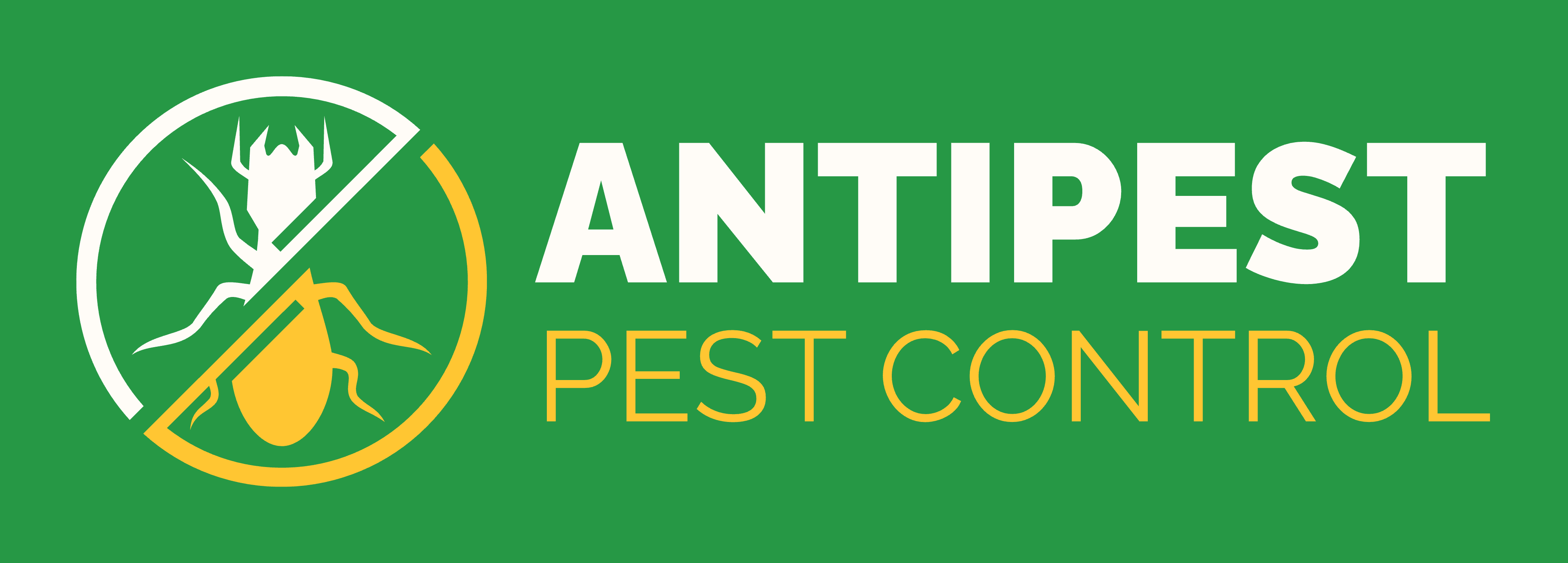Keeping a home free from tiny invaders starts with understanding their habits and removing what attracts them. When kitchens, bathrooms, and gardens become active pathways, colonies can establish quickly, which is why knowing how to get rid of little black ants matters for lasting relief. These ants thrive on easy food and water, slipping through hairline gaps to build satellite nests indoors.
The following guide explains how to get rid of little black ants using safe home practices, natural methods, and professional strategies, so infestations fade now and stay gone later. By focusing on sanitation, bait placement, and prevention, it becomes easier to stop trails and block future reinvasions, this is the practical backbone of how to get rid of little black ants.
Table of Contents
Why Little Black Ants Invade Homes?
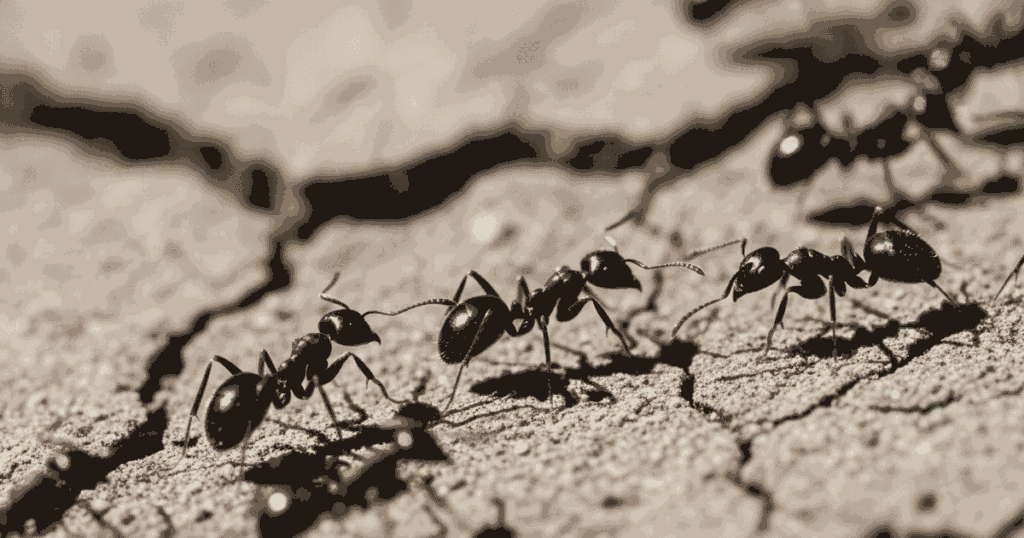
Little black ants don’t randomly appear; they are naturally drawn to homes because of easy access to food, moisture, and shelter. Understanding why they enter is the first step in learning how to get rid of little black ants effectively. If the goal is truly how to get rid of little black ants with lasting results, start by removing attractants and sealing entry points. These practical steps create a foundation for how to get rid of little black ants without constant reinfestations.
They are primarily attracted to:
- Sweet foods like sugar spills, fruit, or syrups
- Greasy crumbs around stoves and counters
- Moisture from leaky pipes or damp wood
- Protection from hot or rainy outdoor conditions
When one ant finds a food source, it leaves behind a chemical trail, quickly leading to long lines of invaders. Ignoring just a few can easily lead to a full infestation, how to get rid of little black ants.
Signs of a Little Black Ant Infestation
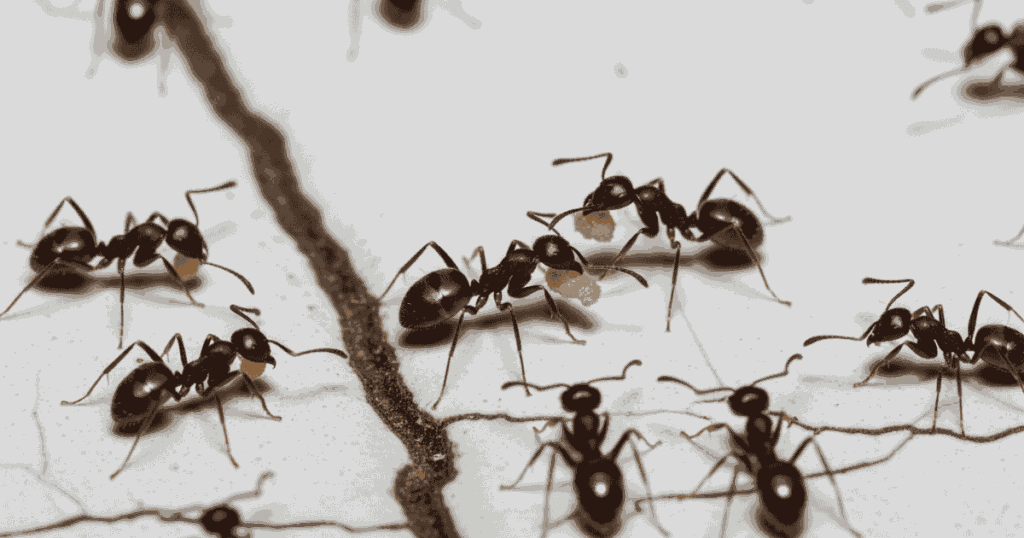
To begin treatment, you must first confirm whether these tiny ants have infested your space. Recognizing the signs early makes it easier when figuring out how to get rid of little black ants before colonies become too large.
Common signs include:
- Small trails of ants, usually around the kitchen or bathroom
- Nests in wall crevices, cracks, or under sinks
- Ants clustered near sweet foods or sugary spills
- Presence of winged ants, which may signal mating colonies
How to Identify Little Black Ants?
Correctly identifying these insects matters before choosing the right treatment. Many ant species look similar, but their behavior and colony structure differ.
Signs You’re Dealing with Little Black Ants
- They measure 1/16 to 1/8 inch long.
- They are dark brown to jet black in color.
- Their colonies are large and can have multiple queens.
- Slow-moving lines of ants often appear indoors in kitchens and bathrooms.
Common Confusion with Other Ants
Little black ants are often mistaken for pavement ants. However, pavement ants are slightly larger with ridged bodies, while little black ants look smooth and shiny.
| Feature | Little Black Ants | Pavement Ants |
| Size | 1/16 – 1/8 inch | 1/8 – 3/16 inch |
| Color | Dark brown/black | Brown/black |
| Movement | Slow, organized | Faster, scattered |
| Queens per Colony | Multiple | Typically one |
Common Infestation Signs and Risks
| Sign of Infestation | What It Means | Risk Level |
| Long lines of ants | Foraging trails to food sources | Medium |
| Ants near water areas | Possible nest close to damp plumbing | Medium |
| Piles of soil indoors | Nesting inside walls or cracks | High |
| Winged ants flying | Reproduction and possible new colonies | High |
How to Get Rid of Little Black Ants: Step-by-step 14‑day action plan
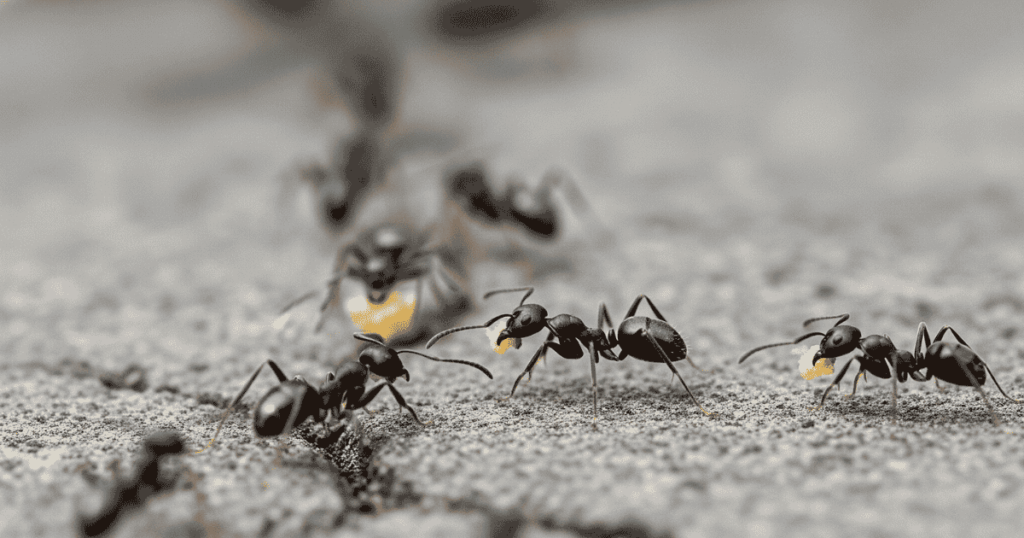
This practical timeline helps structure how to get rid of little black ants without gaps that allow rebound. It balances sanitation, baiting, and perimeter work, then verifies results.
- Days 1–2: Deep clean counters, floors, pet bowls; store food airtight; fix leaks that attract foragers; map trails and entry points.
- Days 2–3: Place sweet gel bait dots every 1–2 feet along trails and beside entry cracks; avoid cleaning right over bait placements.
- Days 3–5: If bait uptake slows or ants ignore sweets, rotate to protein/oil baits; refresh old placements to maintain moisture and appeal.
- Day 4: Apply exterior residual spray at foundation, door thresholds, and utility lines; keep 12–18 inches treated band clear of mulch.
- Days 5–10: Maintain bait availability; don’t spray over bait; wipe trails with vinegar only where no bait remains; dust hidden voids with DE if accessible.
- Days 10–14: Reinspect at dusk when trails are active; if winged ants or persistent traffic persist, expand bait perimeter outdoors and reassess sanitation.
Natural Ways on How to Get Rid of Little Black Ants?

If you prefer a safe, chemical-free approach, natural remedies are highly effective for interrupting trails and reducing colonies. These solutions are especially useful indoors where children or pets may come into contact with surfaces.
Vinegar Spray
How to get rid of little black ants starts with erasing scent highways. Vinegar masks the pheromone trails ants follow. Mix equal parts vinegar and water, then spray on entry points. This disrupts their communication and discourages them from coming back. How to get rid of little black ants becomes easier when trails are erased at the source.
Baking Soda and Sugar Bait
For how to get rid of little black ants without harsh chemicals, mix baking soda with sugar in equal parts. Place the mixture near trails. The sugar attracts the ants, while the baking soda interferes with their digestive system. Keep it fresh for steady results and continue this approach as part of how to get rid of little black ants.
Lemon Juice
Wondering how to get rid of little black ants using pantry items? The acidity of lemon juice works as a natural deterrent. Spray lemon-water solutions on counters and along cracks where ants are visible. Reapply after cleaning to keep trails disrupted.
Diatomaceous Earth
A reliable non-toxic option for how to get rid of little black ants is food-grade diatomaceous earth, which dehydrates ants. Simply sprinkle it where trails are visible. It’s harmless to humans and pets but deadly to ants; use a thin, dry layer and reapply after sweeping or mopping.
Chemical Solutions on How to Get Rid of Little Black Ants?
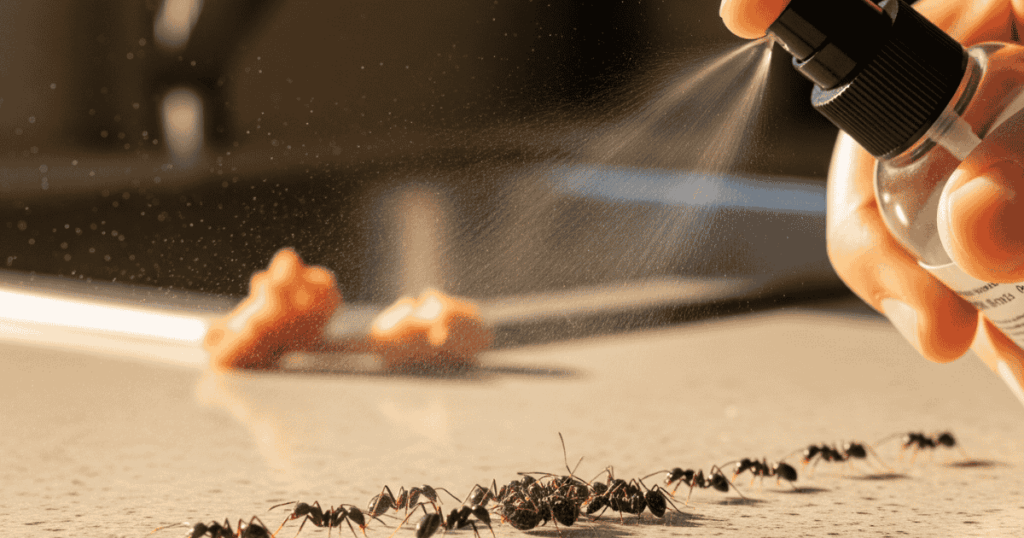
Sometimes natural remedies aren’t strong enough, and how to get rid of little black ants with professional-grade or store-bought treatments becomes the answer. Chemical options work quickly and kill multiple ants in the colony, making them effective if used correctly.
Ant Bait Stations
How to get rid of little black ants effectively often starts with baits. The ants take the poisoned bait back to their colonies, eliminating them from the source and reducing re-infestations.
Ant Sprays
For how to get rid of little black ants in visible trails, sprays offer fast knock-down power. They work instantly but don’t usually affect the colony, so use them as spot control.
Dust Insecticides
When considering how to get rid of little black ants inside walls or cracks, powdered insecticides can be injected into voids. They are strong and should be applied with caution.
Natural vs Chemical Methods
| Method | How It Works | Best For | Safety Level |
| Vinegar & Lemon | Breaks scent trails | Small infestations | High |
| Baking Soda Bait | Poisons ants slowly | Indoor use | High |
| Ant Bait Stations | Spreads poison back to colony | Large infestations | Moderate |
| Sprays & Dusts | Kills on contact, penetrates hiding spots | Severe infestations | Low–Moderate |
Natural Home Remedies on How to Get Rid of Little Black Ants?
For those seeking eco-friendly solutions, home remedies remain popular and effective for minor infestations and maintenance.
Natural Repellents:
- Lemon and Orange Peels: Deters ants with strong citrus scent; can be wiped on floors and counters.
- Peppermint Oil Sprays: Acts as a non-toxic barrier at entry points and in cabinets.
- Coffee Grounds and Baking Soda: Sprinkle in clusters where ants frequently pass; baking soda disrupts digestion.
- Vinegar Solutions: Sprayed in ant trails and nests, vinegar removes pheromone cues and deters further movement.
Natural Repellents vs Chemical Solutions
| Method | Type | How It Works | Suitable For | Safety Level |
| Vinegar spray | Natural | Masks pheromone trails | Ongoing maintenance | High |
| Baking soda bait | Natural | Disrupts digestion | Small indoor infestations | High |
| Ant gel baits | Chemical | Colony extermination | Severe infestations | Moderate |
| Dust insecticides | Chemical | Penetrates nest sites | Hard-to-reach colonies | Moderate |
| Boiling water | Natural | Kills instantly | Outdoor nests | Moderate |
Preventing Future Ant Infestations
Learning how to get rid of little black ants doesn’t end with treatment. Prevention strategies are the real key to keeping them away long-term. Small lifestyle changes go a long way in creating an ant-unfriendly home.
Cleanliness and Food Storage
- Seal food in airtight containers
- Clean crumbs and spills immediately
- Routinely wipe counters with vinegar-based cleaners
Fix Moisture Issues
- Repair leaky pipes and faucets
- Dry damp bathrooms and kitchens promptly
- Ensure proper ventilation in basements and attics
Seal Entry Points
- Use caulk to close cracks and gaps
- Repair window seals and door weather-stripping
- Place mesh screens on open vents
Integrated Pest Management (IPM) for Little Black Ants
How to get rid of little black ants, IPM combines physical, chemical, and biological controls for sustainable, ecological ant management. It is recommended by pest professionals for safe and lasting results.
Key IPM Steps:
- Inspection and Identification: Use sticky traps, inspect along wall edges, and confirm ant type before treatment.
- Sanitation: Remove food and water sources, and regularly deep-clean all surfaces.
- Physical Barriers: Seal off entry points, repair cracks, and use door sweeps.
- Biological Deterrents: Incorporate natural deterrents like mint, citrus peels, and essential oils around windows, doors, and nesting areas.
- Monitoring and Follow-Up: Regularly check traps and treated areas for ongoing activity; adjust treatments as necessary.
Specialized Ant Control Products
Certain infestations demand products specifically engineered for little black ants.
- Maxforce Fleet Ant Bait Gel: Delivers a sweet attractant and advanced kill formula.
- Ant-Trax Gel Bait: Delivers easy-to-use, fast-acting control near high activity spots.
- D-Fense Dust: Waterproof dust ideally applied to wall voids, cracks, and beneath appliances.
- Sumari Insecticide: Spot application in interiors for long-term control.
Always follow manufacturer instructions and consult professionals for persistent infestations.
Long-Term Ant-Free Home Maintenance
Consistent action year-round is key. Here’s an actionable checklist to help maintain an ant-free home:
- Regularly inspect doors, windows, and utility entry points.
- Deep-clean kitchen cabinets, food storage shelves, and pantry.
- Repair leaks and immediately mop up water spills.
- Trim vegetation a minimum of 30 cm from the house foundation.
- Schedule professional pest control every 6–12 months if in high-risk areas.
Professional Extermination Services
If you’ve tried natural and chemical options but still can’t find success, how to get rid of little black ants often comes down to calling a professional exterminator as the most reliable solution. Experts use specialized baits, safe chemical applications, and tracking methods to completely eradicate colonies.
Benefits of professional help include:
- Identification of nest locations
- Stronger, targeted treatments
- Long-term preventive solutions
- Reduced health risks compared to DIY misuse
For comprehensive and hassle-free Black Ant removal and long-term pest prevention, trust the professionals at Antipest Office. Visit us at the Antipest Office, Our trained technicians use safe and effective methods to protect your home and business. For service bookings and consultations, call us at +91 9819018398 .
Conclusion
Little black ants may seem small, but they create big headaches when they infest homes. Understanding how to get rid of little black ants involves both immediate strategies like vinegar sprays or baits and long-term approaches such as sealing entry points and maintaining a clean environment. If infestations grow beyond control, professional extermination ensures total colony removal. By staying proactive, you not only learn how to get rid of little black ants but also how to keep them from returning.
How to Get Rid of Little Black Ants? – FAQs
How to get rid of little black ants fast?
Place sweet gel baits directly along active trails and near entry points; keep surfaces clean so bait outcompetes food, and avoid spraying over bait placements.
What home remedy works on how to get rid of little black ants?
Use a 1:1 vinegar-water spray to erase scent trails, then deploy sugar-and-baking-soda stations in shallow lids; refresh mixes frequently for continued uptake.
How to get rid of little black ants in the kitchen?
Deep clean crumbs and grease, store food airtight, dry sinks nightly, then line trails with small bait dots every 30–60 cm; do not wipe baited spots.
How to get rid of little black ants naturally?
Wipe trails with vinegar or lemon, lay food-grade diatomaceous earth in thin lines under appliances, and apply peppermint oil along cracks to deter entry.
How to get rid of little black ants without harming pets?
Use enclosed bait stations placed behind appliances and under cabinets, choose food-grade diatomaceous earth for dry zones, and avoid open borax mixes.
How to get rid of little black ants permanently?
Combine sanitation, seasonal bait rotation (sweet then protein/oil), and an exterior perimeter barrier; seal cracks and maintain a mulch-free foundation strip.
How to get rid of little black ants in the bathroom?
Fix leaks, improve ventilation, dry sinks and tub edges nightly, then place small bait placements near plumbing penetrations and along baseboards.
How to get rid of little black ants in walls?
Track foraging lines to wall voids, inject dust or place baits near penetrations and outlets, and seal gaps after activity ceases to block re-entry.
How to get rid of little black ants in plants?
Control aphids/scale that produce honeydew, use sticky barriers on pots, and wipe rims with vinegar-water; keep baits away from soil to protect beneficials.
How to get rid of little black ants when baits aren’t working?
Switch to protein/oil baits, reduce competing foods outdoors, expand placements to outdoor nest edges, and add an exterior residual barrier while maintaining sanitation.

